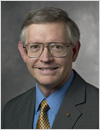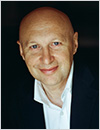Photonics wins again! Chemistry Nobel to Moerner, Betzig, and Hell for superresolution microscopy
SPIE Newsroom
8 October 2014
For the second time in as many days, photonics has been central to a Nobel Prize. Eric Betzig, Stefan W. Hell and William E. Moerner are the recipients of the Nobel Prize in Chemistry 2014 "for the development of super-resolved fluorescence microscopy."
For many years optical microscopy was held back by a presumed limitation: that it would never obtain a better resolution than half the wavelength of light. Helped by fluorescent molecules, the Nobel laureates in Chemistry 2014 ingeniously circumvented this limitation. Their groundbreaking work has brought optical microscopy into the nanodimension.
From the Nobel Prize press release: "Two separate principles are rewarded. One enables the method stimulated emission depletion (STED) microscopy, developed by Stefan Hell in 2000. Two laser beams are utilized; one stimulates fluorescent molecules to glow, another cancels out all fluorescence except for that in a nanometre-sized volume. Scanning over the sample, nanometre for nanometre, yields an image with a resolution better than Abbe's stipulated limit.
"Eric Betzig and William Moerner, working separately, laid the foundation for the second method, single-molecule microscopy. The method relies upon the possibility to turn the fluorescence of individual molecules on and off. Scientists image the same area multiple times, letting just a few interspersed molecules glow each time. Superimposing these images yields a dense super-image resolved at the nanolevel. In 2006 Eric Betzig utilized this method for the first time."
SPIE President-Elect Toyohiko Yatagai noted the significance of the double win for photonics technologies.
"This is wonderful news! The optics and photonics community shares in the pleasure of their awards," Yatagai said. "It is no coincidence that 2015 has been designated by the United Nations as the International Year of Light. We are entering a new era of light, and light-based technologies will break fresh ground, changing all our lifestyles. It is my pleasure that SPIE could contribute to this challenge."



W. E. Moerner, Stefan Hell, and Eric Betzig.
As with the physics Nobel Prize announced the day before, each of the winners is well-known at SPIE events.
W.E. Moerner has been a member of SPIE for 25 years, and has contributed more than 50 papers to SPIE events during that time. He has served as a session chair and program committee member for SPIE Events. A video interview with Moerner appeared in SPIE Newsroom in 2012.
Stefan Hell serves on the program committees of two annual SPIE conferences: Nanoimaging and Nanospectroscopy (SPIE Optics + Photonics in San Diego) and Multiphoton Microscopy (SPIE Photonics West). In addition, Hell has presented more than 60 papers at SPIE events since the late 1980s, and has taught courses for SPIE on Multiphoton Excitation Fluorescence Microscopy. Stefan Hell was also interviewed for SPIE Newsroom, and served on the editorial board of the SPIE Journal of Biomedical Optics for 15 years.
Eric Betzig is coauthor of three papers to be presented at SPIE Photonics West, 7-12 February 2015 in San Francisco.
Daniel Farkas, chair of the microscopy and imaging track at Photonics West, called the microscope "an icon of the sciences -- and in the hands of these innovative scientists and their followers, it has been enhanced to better probe and reveal the intricacies of living matter, down to the molecular level," he said. "This ever-increasing resolution is not forbidden but rather enabled by the underlying physics and chemistry, making for an elegant and highly useful research tool that will undoubtedly continue to flourish and yield new results. Those of us in the biophotonics community are proud of our colleagues' achievements, and sincerely congratulate them."
Bruce Tromberg, Beckman Laser Institute director at UC Irvine, said the award reflects on the importance of "fundamental principles of optics and photonics. Their impact has extended deeply into biology and medicine through innovative concepts and multidisciplinary collaborations," he said. "This further reinforces the importance of optics and photonics as a powerful, enabling technology that drives innovation and discovery, stimulates new fields such as biophotonics and, we hope, will lead to more prizes to come."
